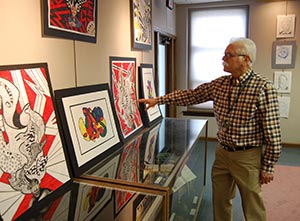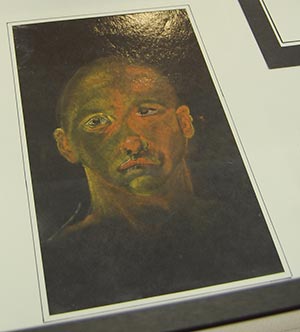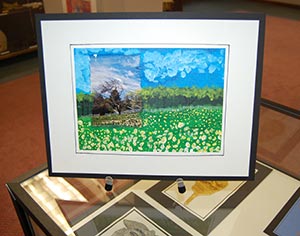Larry Malanowski teaches a different kind of art class. For one thing, he is prohibited from using certain ordinary art supplies with his students – things like scissors and clay are strictly off-limits. And from day to day, he’s never quite sure how large his class will be – it could range from two students to 14.  Larry Malanowski showcases artwork displayed at the Cathedral of St. John the Evangelist, Milwaukee, and created by boys and girls at Wauwatosa Juvenile Detention Center during his 11-year career as an art curriculum teacher. (Catholic Herald photo by Ricardo Torres) View and purchase related photos.
Larry Malanowski showcases artwork displayed at the Cathedral of St. John the Evangelist, Milwaukee, and created by boys and girls at Wauwatosa Juvenile Detention Center during his 11-year career as an art curriculum teacher. (Catholic Herald photo by Ricardo Torres) View and purchase related photos.
But no matter how many kids are in class, at the beginning of each session, he recites “the rules.”
“No rapping, tapping, singing, cussing, swearing or ribbing. If you rib, you’re out. If you react to a rib, you’re out,” he says. “Do not stand up or get out of your seat. No talking between tables, and raise your hand.”
And the penalty for breaking the rules is a little different, too. Far from a simple matter of penance in detention, unyielding students in Malanowski’s class are restricted to their cell block for a day, barred from school and recreation time, and compelled to eat all their meals in solitude.
Malanowski – “Mr. M” to his students – is a longtime teacher at the Wauwatosa Juvenile Dentention Center, where each year several thousand juvenile offenders from Milwaukee County are incarcerated
He teaches boys and girls ages 9 to 17 who have committed a variety of offenses, from petty theft to attempted homicide, and who are serving time that could range from a few weeks to several decades.
Art curriculum is one of their required classes, along with social studies, math, reading and gym. For many, this is their first exposure to art education.
 The painting above, depicting the face of an African-American man, gazing vulnerably, unsmilingly into the viewer’s eyes, drew many admirers. (Catholic Herald photo by Ricardo Torres) View and purchase related photos.“When they’re done with their project, they are like, ‘Oh my gosh’ – they can’t believe that they did this,” said Malanowski. “You get that feeling of accomplishment.”
The painting above, depicting the face of an African-American man, gazing vulnerably, unsmilingly into the viewer’s eyes, drew many admirers. (Catholic Herald photo by Ricardo Torres) View and purchase related photos.“When they’re done with their project, they are like, ‘Oh my gosh’ – they can’t believe that they did this,” said Malanowski. “You get that feeling of accomplishment.”
For the past several years, the work of Malanowski’s students has been displayed for Spring Gallery Night at the Cathedral of St. John the Evangelist, where Malanowski and his wife are parishioners.
“Windows of the Soul,” the current work created by Malanowski’s students was on display at the cathedral last month. The exhibit was a retrospective including student work from throughout Malanowski’s 11-year career at the Juvenile Detention Center – a career which will end when he retires in June.
It is uncertain whether or not the art program at the detention center will continue after Malanowski’s retirement. It depends, he said, on a variety of factors, including finding a replacement and budget considerations.
But it would be a terrible shame to lose the program, said the cathedral’s Deacon Tom Hunt, a close friend of Malanowski who has helped him coordinate the annual exhibits.
“You have to realize that these students of theirs are people who have always been put down in life and got into a situation, so to show some kind of accomplishment like this has got to bring some pride into their life,” he said.
Deacon Hunt volunteers as a chaplain on a weekly basis at the Milwaukee County Jail, and he sees many of Malanowski’s former students there.
“I’ll look at them to see their age, and I’ll say, ‘Were you at juvenile detention center? Did you have art class? Did you have a teacher who had real white hair?’ And they go, ‘Oh, Mr. M!’ And then they actually light up,” he said. “Because I think what he shows them is something they lack in their home life. A lot of their home lives are not really home lives.”
The Windows of the Soul exhibit is just one way that Malanowski and Hunt are trying to show people that the prison population is not so different from the civilian one. Malanowski says his position at the juvenile detention center is, hands-down, his favorite job ever. He has also worked at private and public schools in Milwaukee and the North Shore. A piece of art created by a young person incarcerated at the Wauwatosa Juvenile Detention Center, is displayed during Spring Gallery Night, “Windows of the Soul,” held at the Cathedral of St. John the Evangelist, Milwaukee, last month. The exhibit contained works from throughout Larry Malanowski’s 11-year career teaching art to students in detention. (Catholic Herald photo by Ricardo Torres) View and purchase related photos.
A piece of art created by a young person incarcerated at the Wauwatosa Juvenile Detention Center, is displayed during Spring Gallery Night, “Windows of the Soul,” held at the Cathedral of St. John the Evangelist, Milwaukee, last month. The exhibit contained works from throughout Larry Malanowski’s 11-year career teaching art to students in detention. (Catholic Herald photo by Ricardo Torres) View and purchase related photos.
“I’ve worked in a lot of different places. I’ve worked for kids who will probably never have to work a day in their life, and then I’ve worked with these kids,” he said. “There really isn’t any difference. There were bad kids (at the other schools), too!”
“It’s a little heavy for me because the majority of them are black kids,” said Darin Gordon, Malanowski’s assistant of two years. “So it’s kind of tough on me because I live in the inner city and I see a lot of them. It’s kind of sad, it’s kind of embarrassing – but you work with them and you try to help them, so you start feeling better about the situation because you’re trying to put something back.”
‘How can the hurt be healed?’
The Windows of the Soul exhibit contains around 50 pieces of artwork of various media created by students over the past 11 years. Students’ names are excluded from their work, but the pieces themselves nonetheless speak volumes about the artists who created them.
One pastel painting in particular, said Deacon Hunt, drew more than a few admirers at Gallery Night on April 17. The piece depicts the face of an African-American man, gazing vulnerably, unsmilingly, into the viewer’s eyes.
“They looked at his face; they were drawn to his face, because the face was something that they couldn’t let go of. You can see in his face, there’s hurt,” said Deacon Hunt. “And I guess when you draw something like that, you draw from your inner self, and you wonder – why the hurt? How can the hurt be healed? And I think that one of the things that Larry and Darin do is some healing work. They allow them to express their inner selves which they’re not able to do on the outside.”
Other pieces of art include value sketches, anamorphic drawings in the style of DaVinci, sketches created using the grid method and floral pieces inspired by Georgia O’Keefe.
Each work resulted after a thorough lesson about a particular technique or artist. Malanowski and Gordon work hard to incorporate lessons of history, culture and science into their curriculum. Assignments include presidential portraits and representations of prehistoric etchings found in stone caves in France.
“They memorize what they’re doing and how they’re doing it. Who was the artist, what year was the artist, what type of work the artist did – we review that every day and at the end of the project we have a test on it,” said Gordon. He estimates that less than 10 percent of the students have ever been exposed to art class.
Deacon Hunt feels that the Windows of the Soul exhibit is a wonderful way to remind the cathedral parishioners – and all Christians – that prisoners, too, are beloved children of God. He hopes that, if the detention center is able to find a replacement for Malanowski, his successor will continue the cathedral exhibit.
“There’s very positive feedback, especially about the talent that these young men and women have, how they could challenge their own greatness by doing something that was constructive instead of destructive,” he said. “If you think, you don’t go out of a 12-block radius for most of your life, you do become a product of your environment. We all do. In some respect, you have to understand that. How do you develop a family nucleus when there is no family? Who’s out there for them? Somebody who’s going to show interest in that young boy or young girl and lead them down a path of destruction.”
